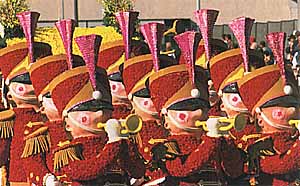
|
The original New Year's Day event consisted of lunch in Sportsman Park
followed by a few competitive games--foot races, egg-and-spoon relays
for the children and a riding contest for the adults.
A family who lived on Orange Grove Boulevard, "Millionaires Row," opted
to weave ivy and garden roses through their buggy spokes for the ride
over to the festivities. Not to be outdone, neighbors braided red and
pink geraniums into their horses and ponies manes and tails, tied satin
ribbons on bridals and reins.
|
|
The colorful group gathered beforehand at the clubhouse, still there on
Orange Grove, and "paraded" east several miles to their destination along
the rutted dirt road strewn with rose petals by the decorating committee.
Voila! The Rose Parade. (Each year since, the Valley Hunt Club has
entered a traditionally garlanded carriage.) It almost was called
something else.
|
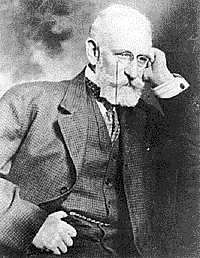
|
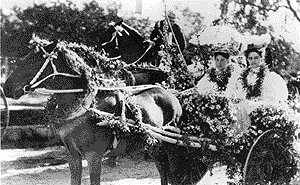
|
Charles Frederick Holder, founder and president of the Valley Hunt Club,
had wanted this January social to be "a combination of fete, fiesta and
tournament to celebrate. . .the ripening of the orange." He suggested
naming this get-together an Orange Tournament. Well, club members felt
the fruit trees in the surrounding groves to be utilitarian but hardly
inspiration enough to rank a place on the club's prestigious calendar.
Dr. Francis F. Rowland preferred a theme akin to Rome's "Battle of
Roses." Others who vacationed in Nice, knew of that city's "battle
of the flowers." The compromise: "The Tournament of Roses."
|
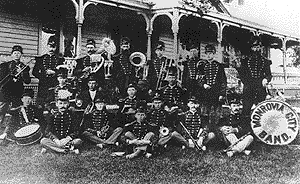
|
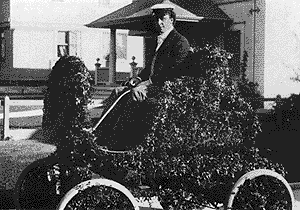
|
More than 3,000 invited guests attended that first year--club members
and friends. The children's games served as a warm-up act for the
bronco riding and steer roping. The grand finale? The Tourney of
the Rings: a test of horsemanship loosely based on Spanish jousting
matches. Club members rode with raised lances, stabbing at rings set
on poles at 30-ft. intervals across the playing field.
|
|
Competitive club members went home and advised their gardeners to plant
flowers that would bloom in time for buggy-enhancing the following year--Jan.,
1891. The private affair sprouted and quickly grew enormous like
Jack's beanstalk. By 1904 the film Ben Hur caused someone to suggested
chariot races as the adult activity. Football had been tried two years
prior and dropped like a fumbled pass. (The pigskin tussle returned of
course, eventually evolving into the "Granddaddy of All Bowl Games.")
Club members standing on a modified two-wheeled cart and sporting togas
raced four-yoke-horses. This proved an easy way for drivers and many of
the thousands of spectators to get hurt.
By 1895, the parade itself, sans picnic and tourney games, enticed
colossal crowds to what was locally called "Tournament" Park on property
currently owned by Caltech. The Valley Hunt Club withdrew their sponsorship,
allowing the city to take over. The newly formed non-profit Tournament
of Roses Association, recruited several knowledgeable male club members.
|
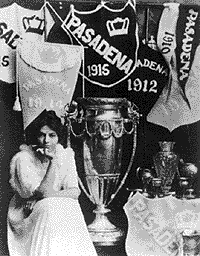
|
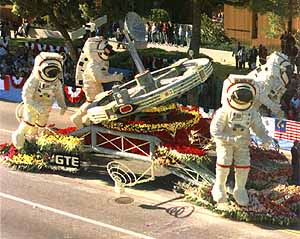
|
With a keen business eye, the professional men favored loosening entry
restrictions. They welcomed bands and floats from outside Pasadena and
gave local hotels a chance to participate. And they embraced the general
public. Doesn't everybody love a parade? Great PR for the Chamber of
Commerce. Rose Parade attendance soared to 50,000 in half a decade.
And, thanks to word-of-mouth advertising, the Crown City soon rivaled
other upscale vacation spots.
. By 1898 the well-advertised "Pasadena Paradise" lured wary east coast
reporters west for the outdoor New Year's observance. These writers who
waxed poetic must have seemed sunstruck to readers buried under snow at home.
President William McKinley couldn't resist; he jumped on a train and
came to see the moving flower show for himself.
|
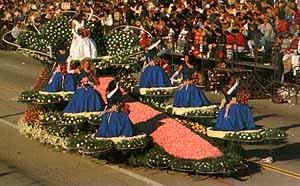
|
Motion picture moguls in Hollywood ambled over two years later. Vitascope
Company filmed the civic production and showed it successfully in theatres
across the county circa 1900.
Five chugging tin lizzies decorated to full-throttle with red carnations
and daisies got the green flag in 1901. These dust-raising horseless
carriages officially mechanized the parade and shall we say drove it
into the 20th century. Next came the era of sensational-sized floats as
these early motorized barges came to be called. Once, a tall creation of
the Hotel Green tangled with telephone wires. The wires were elevated
permanently, ironically encouraging the building of higher and higher
"petal-pushers." Soon a towering 41-foot whale spouted carnation-scented
perfume 25 feet in the air.
|
|
Somehow the requisite pretty "girls" had been overlooked in all the energetic
fun. Easily rectified. A call to Pasadena Junior College and a contest
was set-up during gym classes. A 1905 PJC student, Hallie Woods,
graced the first Queen's float in a dress she made herself, inaugurating
the royal tradition. Two dozen ladies in waiting attended her successor,
Elsie Armitage--the largest court in tournament history. Next, May
Sutton won at Wimbledon and also secured the queenship. Fay Lanphier
reigned as Rose Queen in 1926 and later as Miss America. (Today's
court of seven lithesome ladies are selected from local high schools
by a committee of tournament judges.)
|
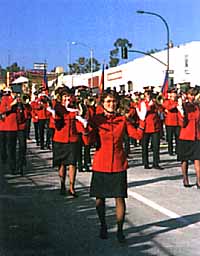
|
|
During World War I, the association sent invitations to businesses in
the South Pacific and Asia touting Southern California's appeal,
emphasizing Pasadena's busy New Year's schedule with everything coming
up roses. Hotels from Yokohama and Manila entered the parade in 1917
while the battle to dominate Europe raged on. A decade later, the first
European government to do so, Czechoslovakia asked to take part. Now
international entries are common place.
Commercial floats designed and built by professionals and backed by corporate
funding received the go-ahead in 1935 forever altering the "home-grown"
flavor of the parade. Although some cities like South Pasadena still
try to turn their float building into a community project.
|
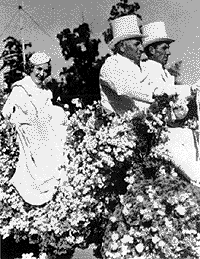
|
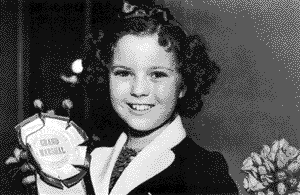
|
A local station televised the Rose Parade in 1947 in black and white to
seven-inch screens in a few homes and bars. The networks took notice four
years later. By 1954 living-color brightened tens of millions American
living rooms. The Rose Parade and Game ranked up there with quiz shows
and "I love Lucy." And the rest as they say is history.
|
|
What other small town floral-happening has blossomed into an international
media event? Early New Year's morning with a million spectators from
around the world crowding the legendary parade route (which sticks close
to the original), the network cameras roll.
The 450 million viewers in 60 countries who tune in Jan. first see live action:
300 equestrians, 22 marching bands and approximately 70 stunning floats
covered with anything that grows from pine cone bark to sunflower seeds and
exotic orchids. No doubt under a turquoise canopy of sky seemingly tied
down by the long purple ribbon of San Gabriel mountains looming on the
northern horizon.
|
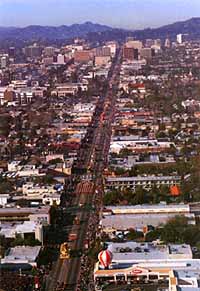
|
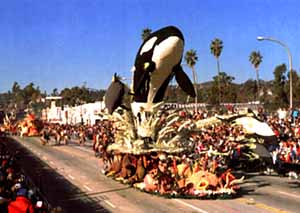
|
Incredible. Those pioneer scions of society who belonged to the Valley Hunt
Club at the turn-of-the-century just wanted a sensible outing on New Year's Day.
They couldn't have predicted their picnic would someday evolve into the most
spectacular parade in the world--a fusion of entertainment and technology.
A darn successful picnic.
|












